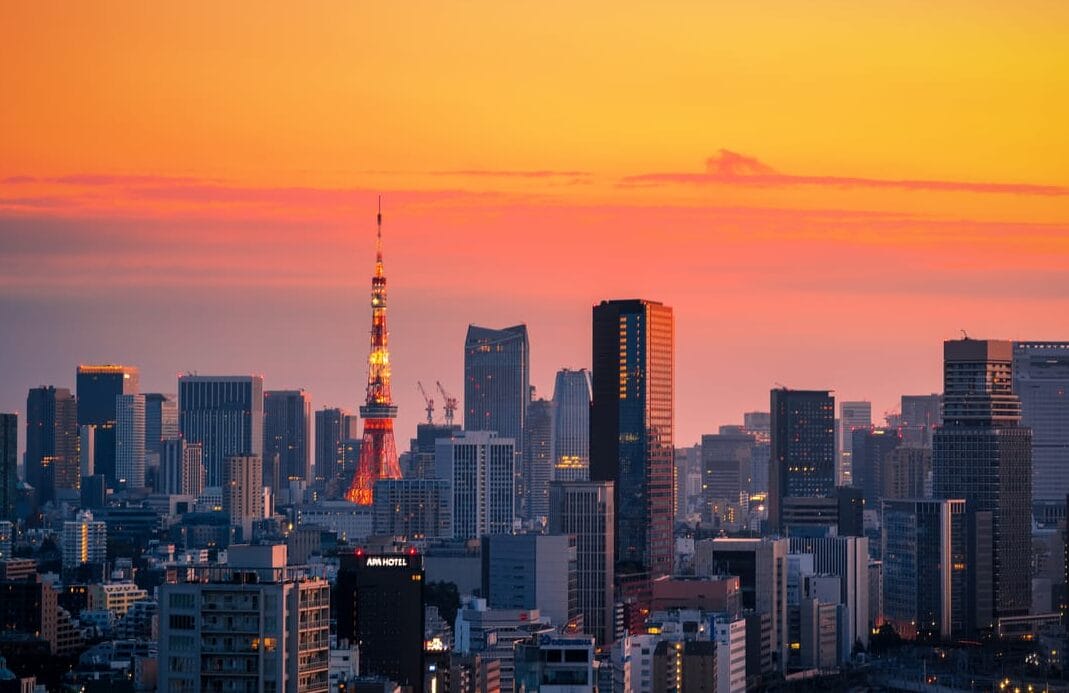Japan’s allure is a tapestry woven from the threads of stunning natural landscapes and a cultural heritage that dates back centuries. Throughout your journey in this captivating country, you’ll be greeted by breathtaking sceneries crafted by its bountiful nature.
This abundance of natural beauty often intertwines with renowned tourist attractions, featuring historic structures and cultural landmarks harkening back to bygone eras.
However, Japan is a land of contrasts, and you’ll also encounter modern metropolises with their vibrant urban landscapes.
As you traverse this remarkable nation, you’ll discover an array of exquisite destinations that beckon you to explore. From ancient temples to bustling cities and serene natural wonders, Japan offers an extensive and diverse collection of places to explore.
With countless beautiful locations waiting to be discovered, Japan’s incredible variety promises to astonish you as you embark on a journey through this captivating land. Here, we’ve handpicked 20 Best Places To Visit In Japan that truly merit a visit.
In this blog, we will cover the following:
1. Tokyo Tower
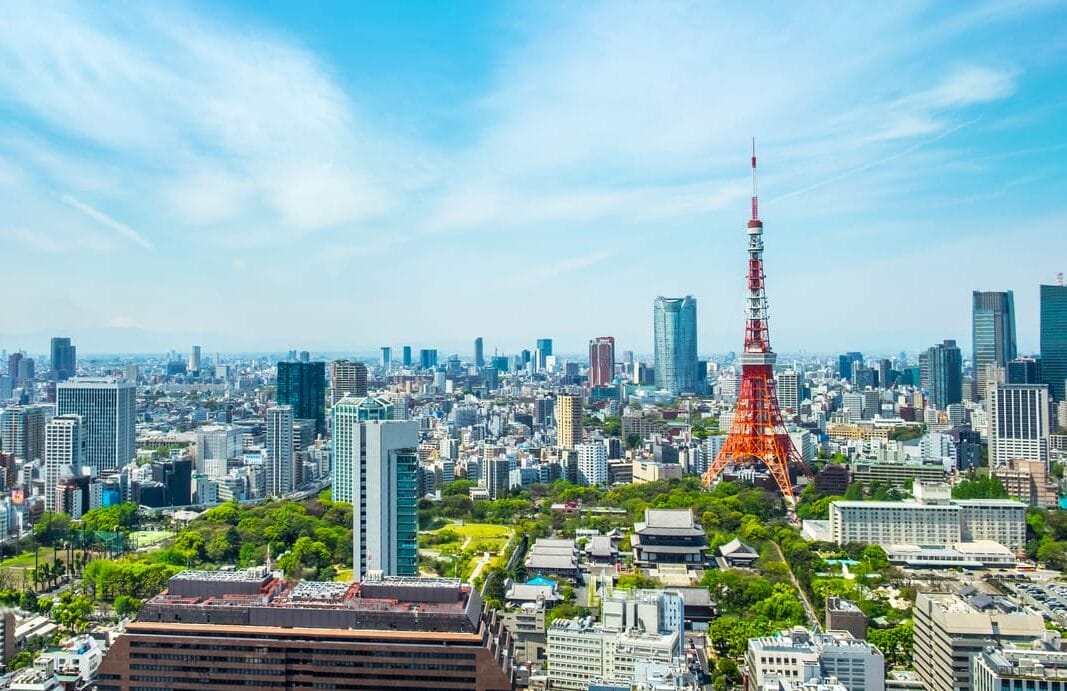
In Tokyo, one iconic attraction stands tall, capturing the essence of Japan’s resilience and progress. The Tokyo Tower, a striking structure reminiscent of the famed Eiffel Tower in Paris, is not just a communications hub but a testament to the nation’s post-World War II recovery and its rise as an economic powerhouse.
Ascend to its summit, and you’ll be rewarded with a breathtaking panoramic view of Tokyo, a city that combines tradition and innovation in a mesmerizing blend.
2. Osaka Castle
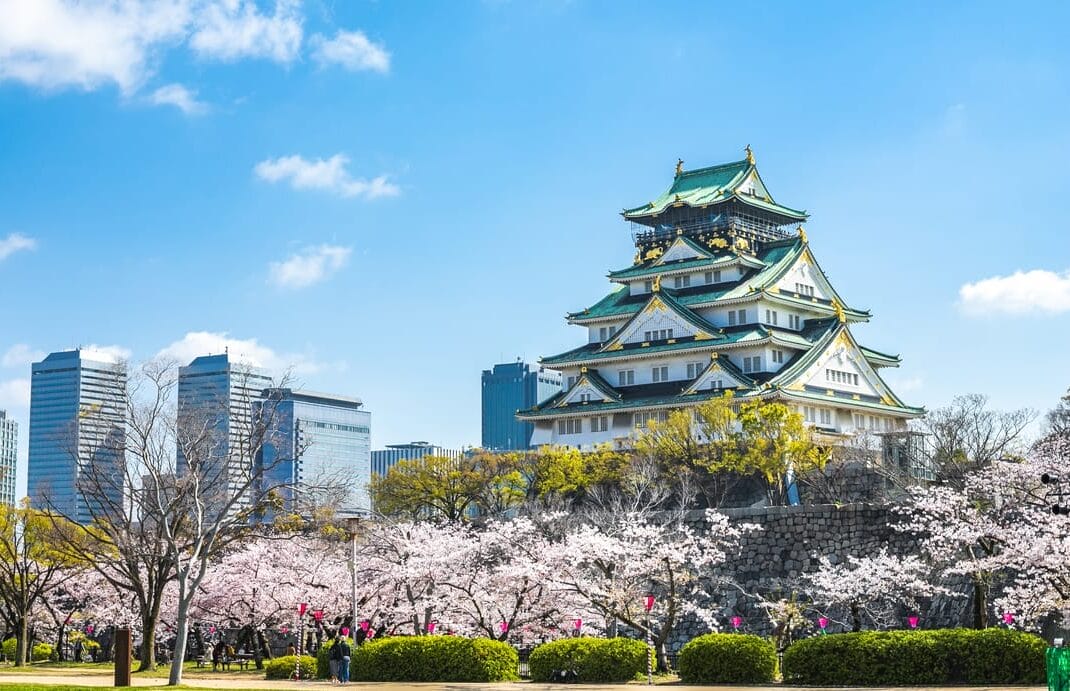
In the heart of Osaka is a historic gem called Osaka Castle. It was founded in 1586 under the watchful eye of the renowned Japanese warrior Toyotomi Hideyoshi.
This majestic castle has witnessed the ebb and flow of history, necessitating its reconstruction following periods of turmoil. Standing tall as one of Japan’s grandest castles, the Osaka Castle boasts a magnificent main tower, soaring 42 meters into the sky with its five stories.
Inside, a museum unravels the castle’s rich history and offers captivating exhibits that delve into the city’s past. Explore this iconic landmark, and you’ll be immersed in the legacy of Osaka and its enduring resilience.
3. Universal Studios Japan

Step into a world of cinematic wonder at Universal Studios Japan, the very first Universal Studios theme park to grace foreign shores. This sprawling entertainment paradise spans 10 captivating zones, each offering a unique immersive experience.
From strolling the streets of Hollywood to navigating the bustling metropolis of New York City, you’ll find yourself transported to iconic movie settings.
Don’t miss the crown jewel of the park, the Wizarding World of Harry Potter, unveiled in 2014 to widespread acclaim. Explore its enchanting streets and magical attractions, a dream come true for fans of the beloved wizarding saga.
Spanning a vast 108 acres, Universal Studios Japan is a playground of exhilarating rides and roller coasters, including the heart-pounding Flying Dinosaur.
Dive into the world of computer-simulated adventures with Despicable Me Minion Mayhem, and satisfy your cravings at themed cafes and restaurants that cater to every taste.
4. Osaka Aquarium Kaiyukan
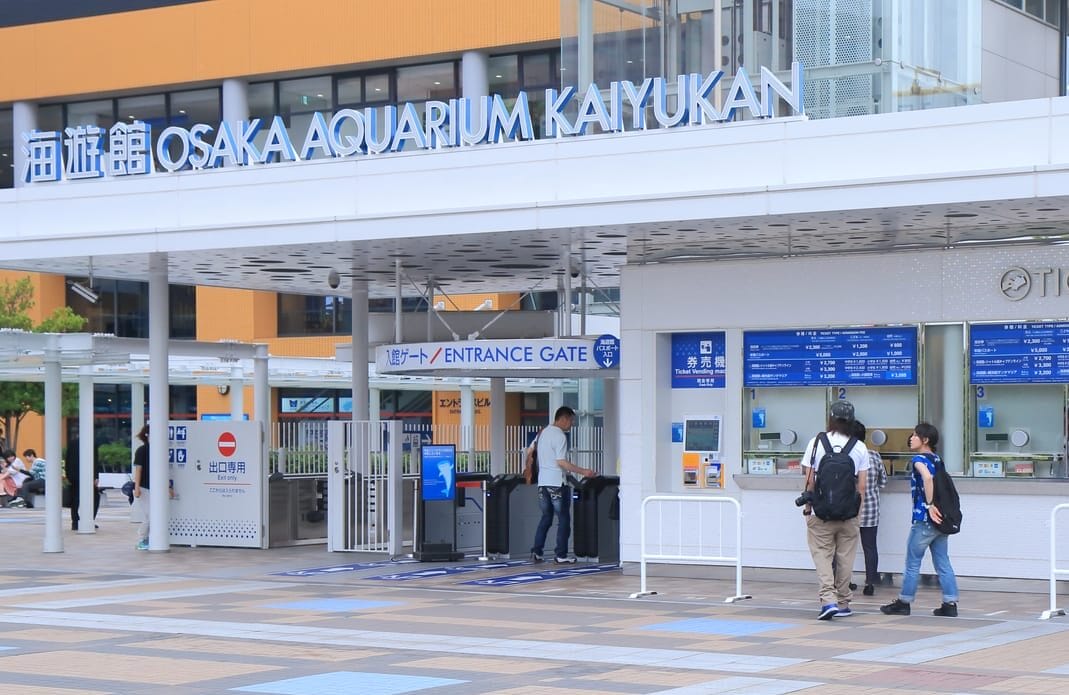
Osaka Aquarium Kaiyukan is a marvel of architectural design resembling colossal Lego blocks. This aquatic wonderland ranks among the world’s largest aquariums, promising an unforgettable journey into the depths of the ocean.
Here, you’ll encounter a breathtaking assembly of several thousand marine and wildlife species hailing not only from Japan but also from far-flung corners of the globe, including Antarctica, the Pacific Ocean, the Great Barrier Reef, and the Monterey Bay.
With 27 expansive tanks to explore, the aquarium offers a splendid opportunity to marvel at freshwater marine life, alongside native Japanese mammals and reptiles.
For an even more remarkable experience, consider visiting the aquarium at night when the tanks are beautifully illuminated, creating a magical ambiance that will leave you spellbound.
5. Tokyo National Museum

The Tokyo National Museum proudly stands as Japan’s oldest and most extensive among the nation’s esteemed national museums. Alongside its counterparts, the Kyoto National Museum, the Nara National Museum, and the Kyushu National Museum, it represents the pinnacle of cultural and historical preservation in the country.
Its origins trace back to 1872 when it was initially established within the premises of the Yushima Seido Shrine. Shortly thereafter, the museum found its permanent residence within Ueno Park.
Distinguished by its remarkable stature, the Tokyo National Museum houses an expansive and unparalleled collection of art and archaeological treasures, exceeding 100,000 individual items, including nearly a hundred national treasures of unparalleled historical and cultural significance.
Within its grand halls, approximately 4,000 distinct items from this extensive and diverse collection are on public display at any given time. The museum’s dedication to cultural enrichment is further evident through its hosting of regular temporary exhibitions.
Visitors will find readily available English information and audio guides, ensuring a rich and informative experience as they explore the riches of Japan’s heritage.
6. Ghibli Museum

Studio Ghibli stands as a shining beacon of Japanese artistic brilliance, captivating hearts around the world with its emotionally resonant and masterfully crafted animated films.
For those drawn to the enchanting world of Miyazaki Hayao and eager to delve deeper into the magic of Ghibli, a pilgrimage to Tokyo’s Ghibli Museum in Inokashira Park, Mitaka, is an absolute must.
Here, you’ll find a treasure trove of wonders, from life-sized figurines and intricate robots to intricate drawings and original drafts. The museum offers a mesmerizing journey allowing you to immerse yourself in the artistry that has brought beloved characters and fantastical worlds to life on the silver screen.
It’s a pilgrimage that promises to ignite your imagination and deepen your appreciation for the enchanting realm of Studio Ghibli.
7. Mount Fuji

Mount Fuji, or as the locals lovingly refer to it, “Fuji-san,” stands as a majestic testament to Japan’s natural and cultural heritage. This iconic Stratovolcano, soaring proudly to an elevation of 3,776.24 meters, graces the southwestern landscape of Tokyo.
Nestled within the embrace of the Fuji-Hakone-Izu National Park, it is part of Japan’s revered “Three Holy Mountains,” alongside Mount Tate and Mount Haku.
Fuji-san, with its awe-inspiring stature, serves as an enduring symbol of both scenic beauty and cultural significance. Its allure transcends borders, beckoning travelers from across the globe to marvel at its splendor.
Beyond its breathtaking vistas, Mount Fuji embodies the very essence of Japan, intertwining nature and culture in a harmonious tapestry that has captured the world’s imagination for generations.
8. Tokyo Disney Land

Covering about 115 acres, this colossal theme park stands as an epitome of entertainment in Tokyo. Whether you’re on a solo adventure, sharing the experience with children, or indulging in a romantic escapade with your partner, it promises you an unforgettable journey.
Notably, it holds the distinction of being the first Disneyland established beyond the United States, forever etching its mark as a premier attraction in Japan.
Within this enchanting realm, a world of mind-boggling rides and delectable cuisine awaits your exploration. Moreover, the adjacent Tokyo DisneySea, a waterpark of equal opulence, invites you to immerse yourself in aquatic delights.
Tokyo Disneyland and Tokyo DisneySea together create a symphony of enchantment, ensuring that your visit is nothing short of magical.
9. The Great Buddha of Kamakura

Bestowed with the esteemed title of Japan’s National Treasure, the magnificent bronze statue of Amitabha Buddha, residing as the primary icon within Kotoku-in, is renowned far and wide as the Great Buddha of Kamakura, or “Kamakura Daibutsu” in Japanese vernacular.
This monumental statue’s genesis traces back to the year 1252 when the process of its creation was set in motion. Initially, it found its sanctuary within the grand edifice of Daibutsu-den Hall.
However, the annals of time witnessed its gradual transformation. Over the years, a series of typhoons assailed the structure, and the coup de grâce was delivered by a colossal tsunami in the year 1498. Subsequently, the resplendent Buddha emerged from the vestiges of its shelter, exposed to the elements and the passage of time.
With a towering height measuring 13.35 meters, inclusive of its monumental base, and a staggering weight nearing the threshold of 121 tons, this awe-inspiring Buddha statue stands as an unequivocal testament to the ages, beckoning travelers from near and far to behold its grandeur.
10. Zao Snow Monsters
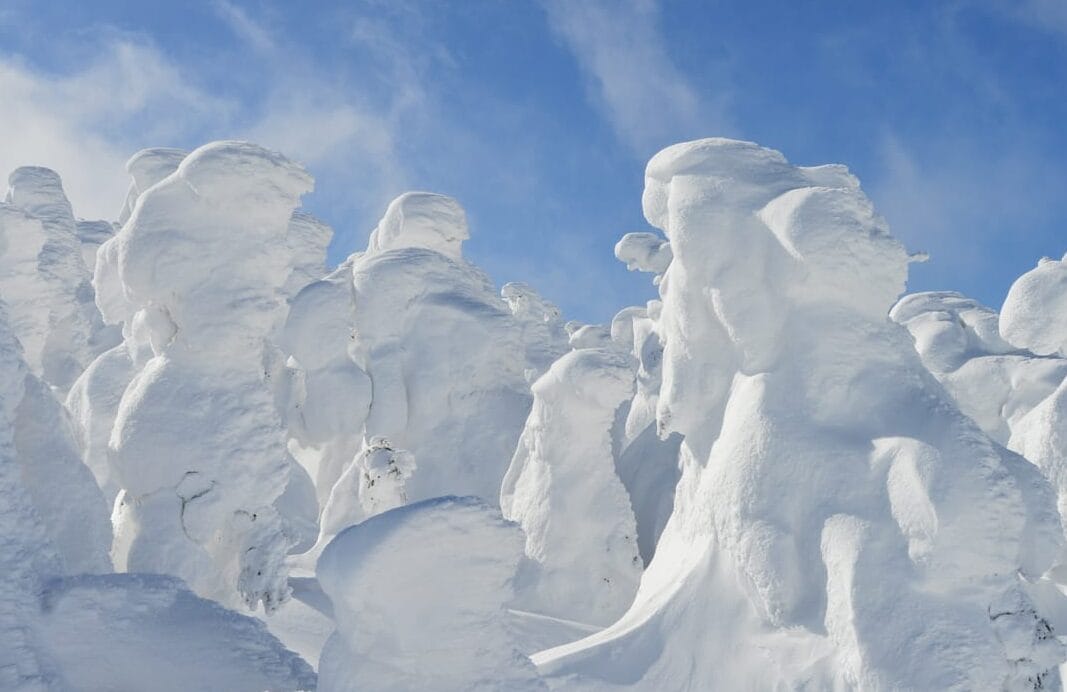
Dubbed by various names like “snow monsters” or “ice monsters,” the extraordinary natural occurrence called “juhyo” graces Mount Zao’s upper subalpine areas every winter, leaving onlookers spellbound.
Located just beneath Kumano Peak, these elevated regions of Zao are populated by Maries’ fir trees, resilient evergreens native to Honshu’s central-northern mountainous regions.
These hardy trees endure the region’s scorching summers and freezing winters. However, from late December to mid-March, relentless Siberian winds sweep across the North Japan Sea and Yamagata’s western plains.
Under this onslaught, Zao transforms. Two to three meters of snow blanket the land, encasing Maries’ fir trees in a layer of freezing condensation.
This unique interplay between weather and tree species creates the juhyo phenomenon—an ongoing cycle of ice formation, turning these unassuming fir trees into towering, surreal ice sculptures.
Strolling among the juhyo feels like entering a Dr. Seuss book, though on a chilly, overcast day that lends an air of mystery to this fantastical landscape.
11. Lake Chuzenji
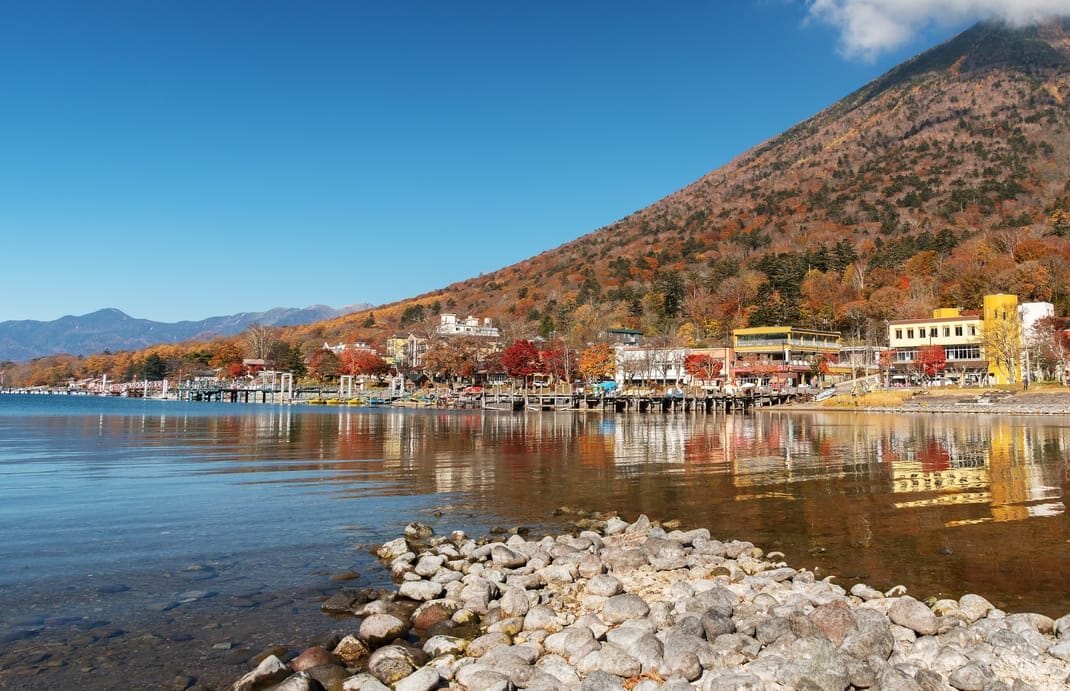
Around 20,000 years ago, the eruption of Mt. Nantai gave birth to Lake Chuzenji, nestled at its base. This lake, standing at an impressive altitude of 1,269 meters, claims the title of Japan’s highest natural lake. A picturesque 25-kilometer hiking trail skirts its perimeter, offering breathtaking views of the surrounding landscape.
In the 19th and 20th centuries, Lake Chuzenji was a sought-after summer retreat, adorned with villas owned by foreigners and embassies. The scenic beauty of this region is further enhanced by the vibrant display of blooming azaleas in early summer and the enchanting hues of autumn foliage.
12. Itsukushima Shrine
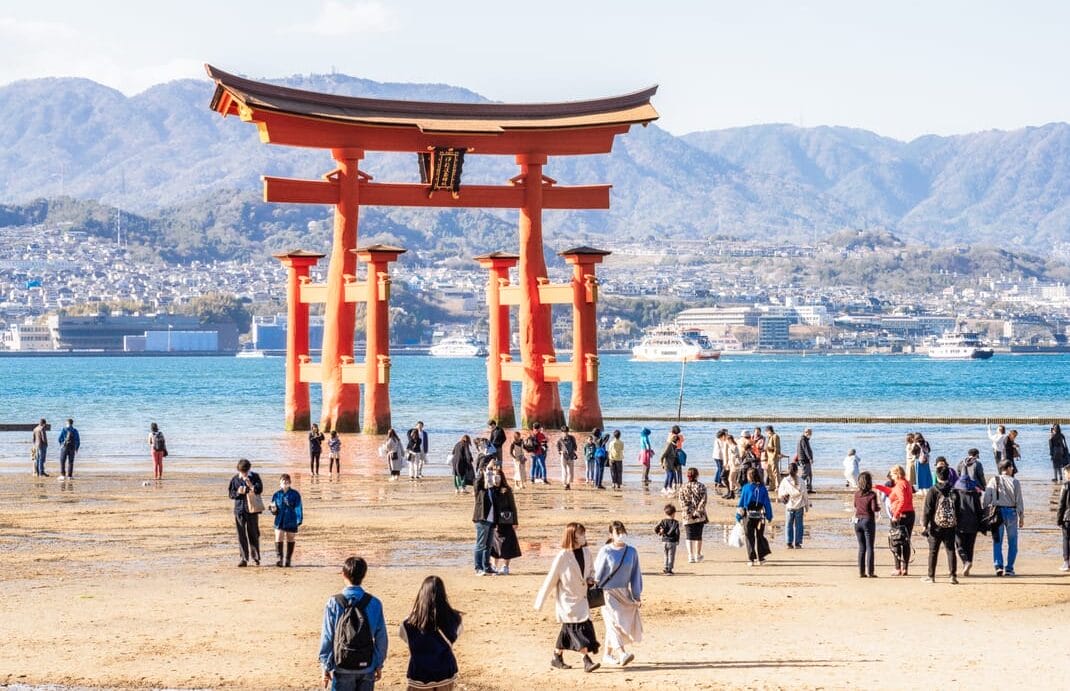
Itsukushima Shrine graces the shores of Miyajima, an island nestled in the Seto Inland Sea, not far from Hiroshima city. While bearing the name Itsukushima, signifying the “island of worship,” it is more renowned as the “floating shrine” due to the illusion created when the tide sweeps in, making the buildings appear as if they are adrift on the water.
The primary shrine complex comprises various structures, including the Purification Hall and a stage for bugaku (court music) performances. These buildings are interconnected by sheltered corridors and adorned with bronze lanterns dating back to the early 20th century.
An arched bridge, erected in 1557, is said to have been traversed by Imperial messengers, serving as one of the vital links between the shrine and the mainland. Notably, Itsukushima boasts a Noh stage from the early Edo Period, a remarkable feature as it is the sole Noh stage in the country that appears to float upon the sea.
In recognition of their historical significance and distinctive design, the structures of Itsukushima Shrine were accorded the status of a National Treasure in 1952 and later earned the esteemed title of a UNESCO World Heritage Site in 1996.
13. Yamadera Temple
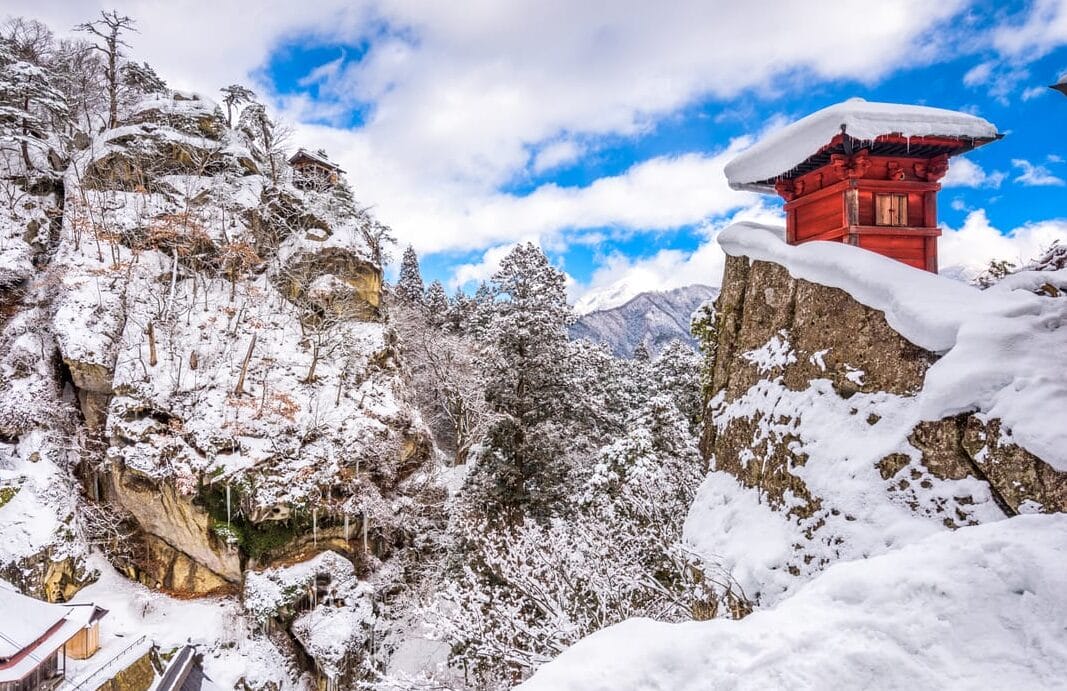
Just beyond the confines of Yamagata City, lies the mesmerizing ancient Buddhist temple complex known as Yamadera Temple. Formally recognized as Risshakuji, it is locally referred to as Yamadera, a name that perfectly encapsulates the congregation of spiritual edifices meticulously carved into a steep mountainside, overlooking the charming village that shares its name.
Yamadera directly translates to “mountain temple” and can be reached via train or car from Yamagata City’s Yamagata station. Embarking on the ascent of over a thousand stone steps leading to this mountain temple, one inevitably surrenders to the profound tranquility enveloping the dense forest and the multitude of stone-carved memorials scattered along the path.
Upon reaching the awe-inspiring Niomon gate at the summit, take a moment to catch your breath and contemplate the silent, guardian cedars that envelop you. Ascending further to Godaido, nestled along the cliff’s edge, you can allow your gaze to wander across the valley below and extend toward the mountainous horizon.
Here, you may briefly ponder the eternal cycles of the seasons that grace this world, whether or not we are present to witness them.
14. Himeji Castle

Himeji Castle stands as a testament to Japan’s most magnificent castles. Revered for its imposing size, exquisite beauty, and impeccably preserved, intricate castle grounds, it holds the distinction of being a national treasure and a UNESCO World Heritage Site.
Unlike many of its counterparts, Himeji Castle has withstood the test of time, remaining unscathed by the ravages of war, earthquakes, or fire, making it one of Japan’s rare twelve original castles.
Strategically situated along the western route to the former capital city of Kyoto, Himeji Castle’s origins date back to the 1400s when the initial fortifications were constructed. Over the centuries, various ruling clans in the region continually expanded and enhanced the castle.
The complex that stands today was finalized in 1609, comprising an extensive array of over eighty buildings spanning multiple baileys. These architectural marvels are interconnected by a network of gates and winding pathways, forming a breathtaking ensemble that is a testament to Japan’s rich history and architectural prowess.
15. Ogasawara Islands
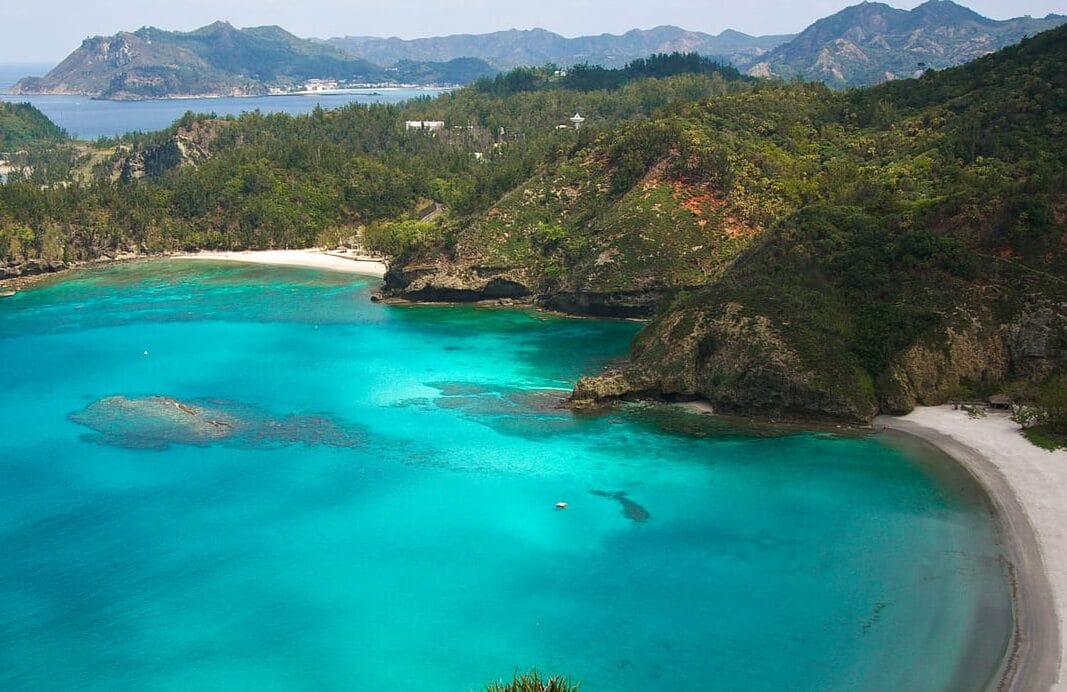
The Ogasawara Islands encompass a sprawling expanse of more than 30 islands, meticulously arranged into three distinct groups, collectively spanning a vast surface area of 7,939 hectares.
This archipelago unfolds a diverse tapestry of landscapes, offering a sanctuary to a plethora of wildlife. Among its precious inhabitants is the Bonin Flying Fox, an exceedingly rare bat teetering on the brink of extinction, and a staggering count of 195 bird species listed as endangered.
The islands themselves boast an impressive botanical heritage, boasting a documented catalogue of 441 native plant taxa. The surrounding waters teem with life, nurturing a multitude of fish, cetaceans, and coral species.
Within the embrace of the Ogasawara Islands, the ecosystems serve as living testaments to an array of evolutionary processes, harmoniously blending plant species.
These species originate from both southeast and northwest Asia, while nurturing a myriad of endemic species found nowhere else on Earth.
16. Shirogane Blue Pond

Situated approximately a 2.5-hour drive from Sapporo, lies the captivating Shirogane Blue Pond. While this stunning aquatic gem may appear as a product of nature, it is, in fact, a meticulously crafted reservoir, conceived in the aftermath of Mount Tokachi’s volcanic eruption.
Its purpose? To shield Biei from the relentless threat of volcanic mudflows. The azure waters of the Blue Pond owe their beguiling hue to carefully introduced chemicals.
What remains a lesser-known fact is that the pond’s cerulean complexion undergoes a mesmerizing transformation, contingent upon the season, weather conditions, and even the time of day. Attempting to pinpoint a singular season for a visit becomes a delightful conundrum, for each season brings forth a distinct allure.
Summer graces the landscape with warmth and radiance, while autumn envelops it in a cooler embrace, enhancing the vivid blue against a backdrop of golden and crimson foliage. Winter casts a spell, turning the pond into a crystalline wonderland, especially enchanting during the night’s wintry illuminations.
Spring unfurls a different but equally magical charm, with temperatures that are more agreeable. However, the optimal moment to behold the pond’s splendor is in the morning, under a clear, sun-kissed sky.
17. Takachiho Gorge

Visualize the leisurely drift of a rowboat through the depths of a volcanic canyon, where the cascade of a waterfall creates enchanting rainbows in the mist that surrounds you.
If this scene stirs your imagination, then make sure to include Takachiho Gorge in Miyazaki Prefecture on your Kyushu travel itinerary. This awe-inspiring gorge owes its formation to columnar jointing—a geological marvel born from the swift cooling of ancient lava. Gazing up at the 17-meter Manai Falls from a boat is a truly exhilarating experience.
The Takachiho region offers more than just the gorge; it boasts splendid shrines and charming inns nestled near the canyon. For a comprehensive encounter with nature, culture, and history, embark on the Takachiho Course, where you can explore the gorge and beyond.
18. Shikisai No Oka Flower Garden
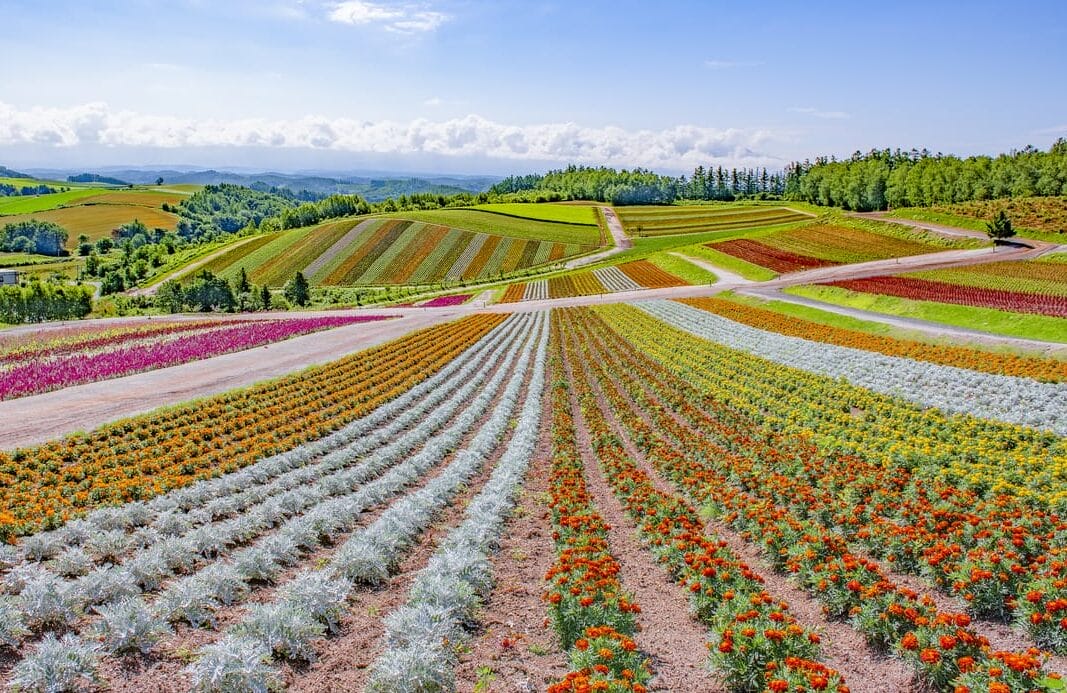
Located in the picturesque town of Biei, Shikisai no Oka, or the Hills of Seasonal Colors, unfolds across approximately 7 hectares in the Furano area. It boasts an extensive array of seasonal flowers that paint the landscape with vibrant hues.
This park is a harmonious blend of rolling hills, ever-changing seasonal blooms, rainbow-hued fields, a delightful restaurant, and a charming souvenir shop. If your visit to Furano coincides with the summer season, a trip to this flower garden is an absolute must.
The picturesque beauty of Shikisai no Oka shines year-round, but it is particularly enchanting during the summer months.
However, do not underestimate the charm of winter here! As the rolling hills don a pristine blanket of snow, the park transforms into a playground for winter sports enthusiasts. They flock to Shikisai no Oka to partake in a variety of cold-weather activities, including exhilarating snowmobile rides and thrilling snow rafting.
On the flip side, spring marks the onset of the blooming season, which continues through the autumn. Regrettably, it’s worth noting that winter is the one season when flowers do not grace this garden.
19. National Museum of Nature and Science
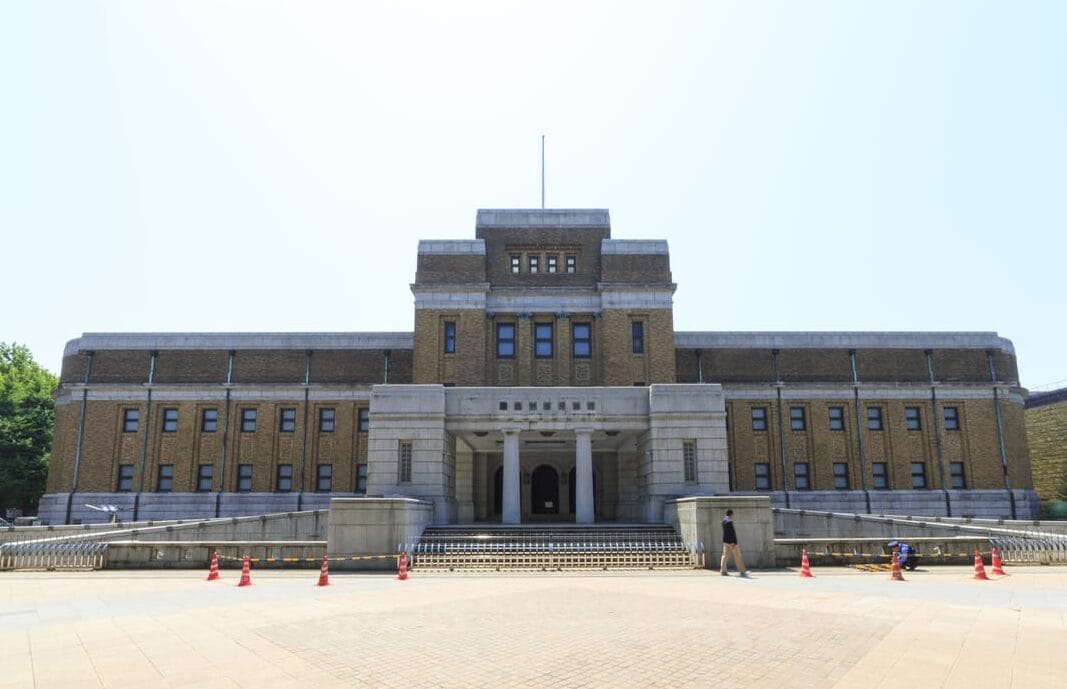
The National Museum of Nature and Science, a prominent institution dedicated to the exploration of science in Japan. Boasting an extensive collection of over 25,000 exhibits, this museum offers comprehensive insights into various facets of world history, encompassing the realms of science, technology, and nature.
Your journey through its halls will bring you face to face with captivating attractions, including a life-sized, authentic dinosaur skeleton that stands as a testament to Earth’s prehistoric past.
You’ll also encounter a fascinating piece of history in the form of the Nantan meteorite, which descended from the heavens in the 16th century, as well as the preserved body of the legendary Hachiko, among a myriad of other intriguing exhibits.
20. Jodogahama Beach

Jodogahama Beach, often referred to as “Pure Land Beach,” stands as one of the most renowned scenic marvels along the Rikuchu Coast. This coastal gem is celebrated for the striking contrast it presents: the rugged, white rocks harmonize with the vibrant green pines, all set against the backdrop of the deep blue sea.
The landscape’s beauty was so breathtaking that it earned a comparison to the Pure Land or Paradise by the revered Buddhist monk Reikyo, thus bestowing the name “Jodogahama” upon it.
This pristine beach holds a special place in Japan’s natural wonders, earning distinctions such as being listed among Japan’s 100 Best Beaches, 100 Best Beaches for Swimming, and 100 Scents of Japan, among others. Jodogahama offers an excellent environment for swimming, boasting clean waters and gentle waves that beckon beachgoers.
The area is well-equipped with essential facilities, including a bus terminal building, a marine house, a rest house, and even a boat rental service.
For those with a penchant for exploration, be sure to keep an eye out for crabs and small fish in the captivating tide pools along the esplanade stretching from the beach to the marine house—a delightful bonus to your beach experience!
Thanks for reading this blog. Check out more blogs like this one here: www.toniagara.com/blog

